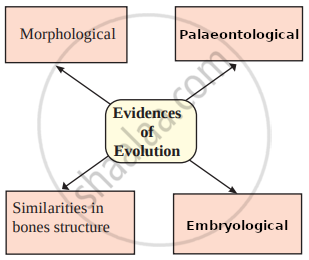Advertisements
Advertisements
Question
Complete the following chart:

Solution

APPEARS IN
RELATED QUESTIONS
Give two examples of vestigial organs in human beings and plants.
Explain with an example for the given, how the following provides evidence in favor of evolution in organisms :
Homologous organs
How analogy and homology considered as an evidence in support of evolution ?
State a reason for the increased population of dark coloured moths coinciding with the loss of lichens (on tree barks) during industrialization period in England.
How do homologous organs help in providing evidence for organic evolution?
Human tailbone is a vestigial organ. Explain.
Select and write analogous structures from the list given below :
1) Wings of butterfly and birds
2) Vertebrate hearts
3) Tendrils of Bougainvillea and Cucurbita
4) Tubers of sweet potato and potato
Out of bacteria, spider, fish and chimpanzee, which organism has a better body design in evolutionary terms? Give reason for your answer.
The presence of which of the following types of organs in two organisms indicates that they are derived from the same ancestor?
(a) analogous organs
(b) respiratory organs
(c) digestive organs
(d) homologous organs
The organs P and Q of two animals have different structures but similar functions. On the other hand, the two organs R and S of two other animals have the same basic structure but different functions.
(a) What are the organs like P and Q known as?
(b) Name the organs like P and Q. Also name the animals which have such organs.
(c) What are the organs like R and S called?
(d) Name the organs like R and S. Also name the animals which have such organs.
Read the following statement and justify same in your own words with the help of suitable example.
There is evidences of fatal science among chordates.
Vestigial organ ______ present in human body is proof of evolution.
Write short notes based upon the information known to you.
Connecting link
Write the names of those animals in whom the human body organs are functioning.
Explain with suitable examples importance of anatomical evidence in evolution.
“Appearance of melanised moths post-industrialisation in England is a classic example of evolution by natural selection.” Explain.
Long answer question.
Would you consider wings of butterfly and bat as homologous or analogous and why?
The decaying process of C-14 occurs continuously in dead organisms only.
Give scientific reason.
Vertebrates have slowly originated from invertebrates.
What is carbon dating?
Observe the following images and answer the questions.

- Which evolutionary evidences are indicated in the given picture?
- How are they formed?
- Which method is used to measure their age or their time?
Select vestigial organs from the following.
Which of these is not a vestigial organ in human beings?
- Define vestigial organs.
- Write names of any two vestigial organs in the human body.
- Write name of those animals in which these vestigial organs are functional.
Homologous organs are:
Which is not a vestigial organ in a man?
The bones of forelimbs of whale, bat, cheetah and man are similar in structure, because ______.
How do we compute the age of a fossil?
The evolutionary story of moths in England during industrialisation reveals, that 'evolution is apparently reversible'. Clarify this statement.
Explain divergent evolution in detail. What is the driving force behind it?
You have studied the story of Pepper moths in England. Had the industries been removed, what impact could it have on the moth population? Discuss.
Explain natural selection with the example of industrial melanism.
Write avian characters of Archaeopteryx.
Industrial melanism was highlighted by ______.
Give examples of homologous organs and analogous organs in plants.
